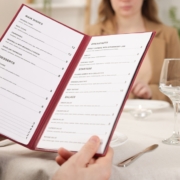Restaurant Menu Types You Should Know
A restaurant menu is not a simple piece of paper, listing all the items an eatery has to offer. It is a powerful tool to impact and shape the dining choices of visitors, which contribute to sales and revenue generation. Menu design plays an important role in achieving this goal.
Strategically mentioning dishes on the menu card using the right font and colors is one thing. The dishes on the menu should also be carefully selected. All of this is dependent on the type of menu you choose for your restaurant.
Scroll into the details of this article to get your hands on restaurant menu types you should know about and choose the best one for your eatery.
Top 5 Types of Restaurant Menus You Can Pick
The success of a restaurant is highly dependent on the popularity of its menu. Choosing the most popular dishes from various restaurants and crafting your menu will not automatically make you popular. You must put more effort and thought into planning your menu to secure desired results. Exploring the types of menus can help you assess and choose the right one for your setup.
Here are the major types of restaurant menus you can pick and choose from for your own setup.
1. Static Menu
A static menu is the basic and most common type of restaurant menu you should know about. This is the type of menu that consists of fixed offerings, which continue for longer periods without any change. The menu can include specific options like signature dishes, special entrées, and customers’ favorites.
The dishes remain the same and allow the restaurant to offer consistent quality over the years. It also makes inventory management easier and helps the restaurants to uphold their image. Fast-food, casual dining setups, and restaurants with an established brand identity opt for a static menu and deliver consistent quality for years.
2. À La Carte Menu
An a la carte menu is another popular menu type, which is adopted by new restaurants. The menu offers greater choice in each category, ranging from appetizers to main courses, desserts, and drinks. Each menu item is individually priced and offers more flexible order placement to the customers.
An a la carte menu offers more liberty to diners to explore the menu and order whatever they want, without putting any restrictions on them. The diners can choose any appetizer and pair it with any main course and enjoy their meal. Individual pricing also helps the authorities manage their costs and expenses smoothly. Cafes, fine dining, and casual dining restaurants usually opt for such a menu.
Contact consultants at Finisya and let experts guide you about the best-suited type of menu for your setup, according to your service.
3. Cycle Menu
Cycle menu is the next type of restaurant menu you should be aware of. The menu follows a cyclic pattern, as the name suggests. The restaurant authorities might plan a specific set plan for every day of the week. For instance, there would be a set but distinct offer for breakfast, lunch, and dinner every day of the week. The same menu would be repeated every week.
Some restaurants even expand the cyclic rotation to a month and not just a week. Cyclic menu streamlines operations, supports better inventory management, and gets loyal customers, all while prioritizing quality. However, it comes with its fair share of risks. You might get fewer customers on days menu offers a less popular dish. Use this as an opportunity to spot trends and implement improvements.
4. Seasonal Menu
Seasonal menu is the next type of restaurant menu you can opt for.. As the name suggests, such a menu relies on seasonal produce. You can develop a menu using ingredients from the best of every season and create signature dishes. For instance, fall is the season of pumpkins, so you can opt for pumpkin soups, cakes, and anything else that allows exclusivity.
The signature seasonal dishes will win over loyal customers and positively reflect on your sales and profits. Besides this, using the fresh produce of every season instead of just the processed ingredients will enhance food quality. It will also boost your restaurant’s popularity and get you increased foot traffic.
5. Tasting Menu
The tasting menu is the last type of menu restaurants can experiment with. Such a menu is designed to offer a tasting opportunity to the diners. The menu can include the best and recommended dishes of the chef, seasonal dishes, and the ones which are still in the testing phase.
The quantity of tasting menu items is intentionally kept minimum so the diners can taste and enjoy everything. A tasting menu can help the diners book you for bigger events and celebrations like engagement, wedding, anniversary, or corporate events. Such menus also help new restaurants get more customers. You can plan days in a month or host specific events to offer a tasting menu only and win over customers.
Which Menu Type Do You Think Is Best For You?
Restaurants must plan and design their menu strategically to win over customers. After the interior, the menu is the next thing that impacts and shapes their overall experience. Do not undermine its power and invest the right resources and expertise in it. Feel free to utilize professional support and stand out among competitors.

